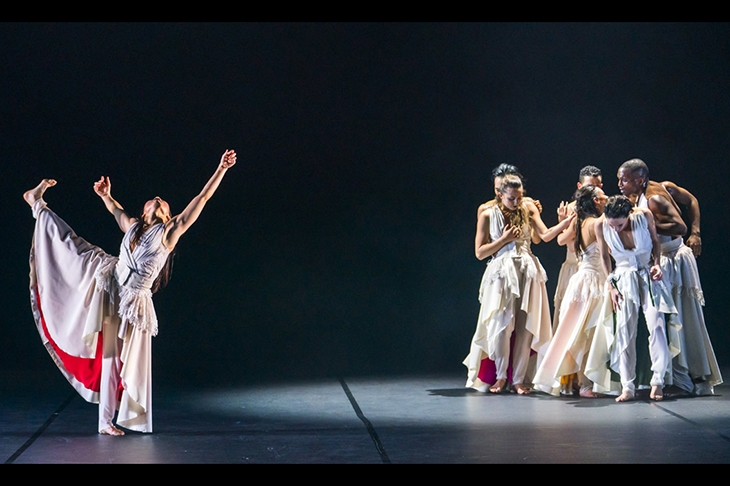It was Stravinsky himself who suggested that, in order to preserve its difficulty, the opening bassoon solo of The Rite of Spring should be raised by a semitone every decade. And it was a performance by Birmingham Royal Ballet in 2005 that convinced me that he wasn’t entirely joking. The audience nattered away over the opening bars; the unlucky bassoonist wobbled and cracked. Clearly, this orchestra was not remotely prepared for what was about to hit it. Rhythms splintered like shrapnel and misplaced entries spattered across every silence. As they hurtled into the final Sacrificial Dance, you could almost hear the prayers of musicians audibly struggling simply to hang on. It’s still, without question, the most thrilling Rite of Spring I’ve ever heard.
No offence is intended to conductor Garry Walker and the orchestra of Opera North when I say that they played it extremely well. This too was a fully staged ballet rather than a concert performance — the first half of a bizarre double bill with an enjoyably (if not sensationally) sung revival of Christopher Alden’s cartoon-funny, Fellini-lite production of Puccini’s Gianni Schicchi, in which Richard Burkhard’s droll, wheedling Schicchi was very nearly upstaged by the lugubrious physical-comedy capers of Tim Claydon as the corpse of Buoso Donati: dead and loving it.
A co-production with the Leeds-based Phoenix Dance Theatre, this Rite was created by Jeanguy SAINTUS (his surname was capitalised throughout the programme book), a Haitian choreographer who has spoken of his interest in voudou ceremonial. The deeper complexities of his work are above the pay grade of a mere music critic, but as his white-clad, barefoot dancers formed and reformed, an aura of ritual shaped by invisible forces was certainly present. Whirling underskirts in primary colours evoked the powdered pigments of a Hindu religious festival; twice, the eight dancers came to rest in the shape of a mandala. And they’d link arms in fours, only for one dancer to destabilise the pattern, sometimes seemingly by accident, more often quivering as if in the grip of a seizure.
Well, that’s how it looked to an engaged but decidedly non-expert observer anyway. Anyone who knows the Rite is waiting for the moment when the sacrificial victim is separated out from the tribe, and in making it clear that any member of the troupe might become that doomed other, Saintus tweaked our expectations, even while drawing cross-hatched patterns of swirling fabric and arched, naked backs. A Chosen One of sorts emerges near the end, but Saintus denies us our blood lust and my mild sense of anticlimax left me feeling, on reflection, slightly ashamed. Funny that after 106 years, the Rite is still such a dangerous plaything.
Which brings us back to the orchestra, and the additional power that Stravinsky’s score accrues when it’s being played in a pit as an accompaniment for dance, rather than as a turbocharged concerto for orchestra. The ON orchestra was raw and brusque, with flushed, tumescent woodwinds and sinewy on-point strings. The pit acoustic strips all glamour from the sound and the conductor — obliged to put the dancers first — does the rest. A performance as tautly handled as this was by Walker, with nervous energy twanging between stage and pit, is surely a million times closer to the Rite that Stravinsky conceived than the usual streamlined concert-hall showpiece. I’m not sure that I’d endorse Stravinsky’s plan to make the Rite harder, but I’d be quite happy to see it confined to its natural habitat.
Meanwhile, if you want to observe the tribal rituals of the classical music world, get along to a touring concert by the Vienna Philharmonic. Tut with disapproval at its institutional misogyny (people seated around me were loudly performing the statutory head count of female players as the orchestra walked on). Note its numbingly conservative repertoire choices. Acknowledge its problematic — to put it mildly — relationship with the Third Reich. Then look around and observe that every seat in the house has been sold.
Adam Fischer conducted Mahler’s Ninth Symphony, a work located at the exact point in the VPO mythos where this great orchestra’s glorious heritage intersects with its ineradicable shame. Fischer took a demythologising approach: lucid, brisk, chilly — presenting as an apocalyptic precursor of the Schoenberg school a symphony that, in other hands, can be as sweet as Johann Strauss. Breathy, translucent low string gestures began and ended the whole vast journey. In between came massive, steel-grey walls of violin tone, scrawled over by bitumen-black bassoons and low brass. There’s a fourth movement horn theme that Mahler marked at a modest forte. The Vienna Phil horns tanked it out loud enough to be heard back on the Ringstrasse. Tradition or travesty? I can’t decide, and like many music-lovers I keep wishing I didn’t have to.






Comments